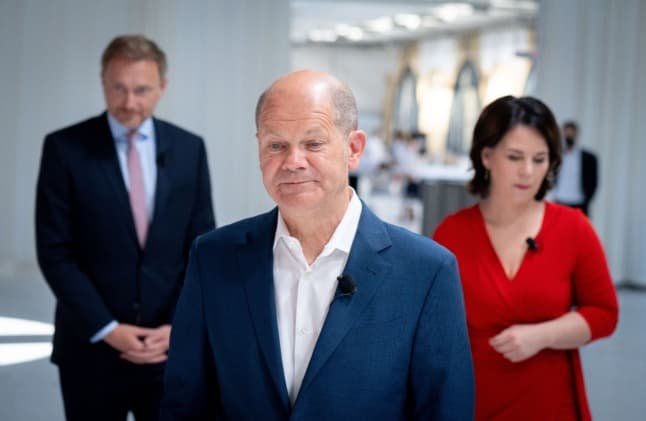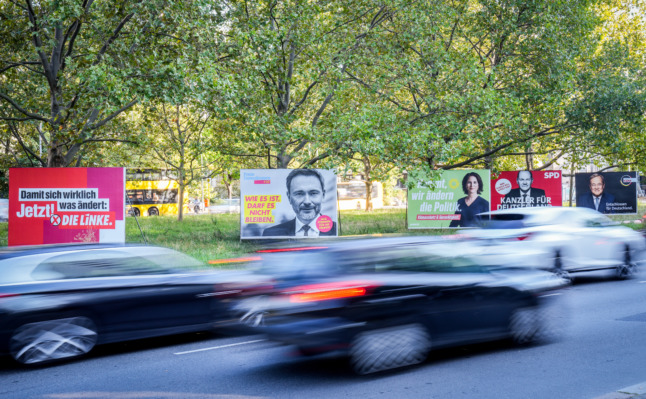From Kenya to Jamaica: Which coalitions are possible after the German election?

Germany is abuzz with talk of traffic lights, Jamaican flags and other nicknames that describe the hotchpotch of possible coalitions that could be formed after Sunday's election.
As the country goes to the polls in its first election for 16 years without Angela Merkel, surveys show the centre-left Social Democrats (SPD) ahead on around 25 percent, with Merkel's CDU-CSU conservative alliance on around 22 percent.
But to govern alone in Germany, a party must have a majority of more than 50 percent.
As a result, whoever wins will need the support of at least one and probably two other parties to govern.
With the margin between the SPD and the CDU-CSU expected to be close on Sunday, both parties could separately begin discussions with smaller parties.
Traffic light
One outcome could see the SPD heading a "traffic light" coalition, a grouping with the Greens - currently polling at around 17 percent - and the liberal Free Democratic Party (FDP), on around 11 percent.
The nickname comes from their party colours of red, green and yellow.
But the liberal party, which has been gaining confidence in opposition under charismatic young leader Christian Lindner, is not a natural bedfellow with left-leaning parties.
Lindner has said the FDP's two red lines would be no tax hikes and reverence for Germany's cherished debt brake, lifted during the pandemic - two policies that could be hard to swallow for the SPD and the Greens.
Red-green-red
The SPD could also potentially opt for a "red-green-red" coalition with the Greens and the hard-left Die Linke, polling on around six percent.
READ ALSO: Election 2021: What an SPD-led coalition could mean for foreigners in Germany
SPD chancellor candidate Olaf Scholz has been under pressure to rule out working with Die Linke, which evolved out of the former East German communist party and has some controversial policies, including opposition to NATO.
But although he has said he would not be willing to compromise Germany's NATO membership, Scholz has not completely ruled out a partnership with the leftists.
Jamaica
A coalition led by the CDU-CSU would be more palatable for the liberals, but the two parties will almost certainly need a third to make up the numbers.
READ ALSO: Election 2021: What a CDU-led coalition could mean for foreigners in Germany
The most obvious candidate here is the Greens, which would result in a "Jamaica" coalition named after the gold, green and black of that country's flag.

Drivers pass campaign posters from the Left, the FDP, the Greens, SPD and CDU. Which of these could work together after the election? Photo: picture alliance/dpa | Kay Nietfeld
On the other hand, when those three parties were in talks to form a coalition after Germany's last election in 2017, the FDP dramatically walked out over disagreements on migration and energy policy.
GroKo, again
Germany's last two governments have been formed of a coalition between the conservative CDU-CSU and the SPD, known as a "grand coalition" or GroKo in German, as these have traditionally been the country's two biggest parties.
Another grand coalition could technically be an option, albeit most likely with the SPD as the biggest party this time.
However, Scholz has previously ruled this out and in a recent TV interview said his "whole aim" was "for the CDU-CSU to get a chance to rest in opposition".
Kenya or Germany
A grouping of the SPD, the CDU-CSU and the Greens could also be a possibility, known as a "Kenya" coalition, as the colours would match the black, red and green of that country's flag.
The SPD could also seek to team up with the CDU-CSU and the FDP - to form a coalition whose colours match Germany's own black, red and gold national banner.
Wild cards
If the SPD and the Greens both do slightly better than expected, there is a chance they could form a coalition alone -- which would certainly make things easier.
If no one can agree, a minority government is also a possibility.
But whatever happens, there are likely to be many weeks of haggling, flirting and backstabbing to come in the weeks after September 26th.
READ ALSO: ANALYSIS: Who could be in Germany’s next coalition government?
By Femke Colborne
Comments
See Also
As the country goes to the polls in its first election for 16 years without Angela Merkel, surveys show the centre-left Social Democrats (SPD) ahead on around 25 percent, with Merkel's CDU-CSU conservative alliance on around 22 percent.
But to govern alone in Germany, a party must have a majority of more than 50 percent.
As a result, whoever wins will need the support of at least one and probably two other parties to govern.
With the margin between the SPD and the CDU-CSU expected to be close on Sunday, both parties could separately begin discussions with smaller parties.
Traffic light
One outcome could see the SPD heading a "traffic light" coalition, a grouping with the Greens - currently polling at around 17 percent - and the liberal Free Democratic Party (FDP), on around 11 percent.
The nickname comes from their party colours of red, green and yellow.
But the liberal party, which has been gaining confidence in opposition under charismatic young leader Christian Lindner, is not a natural bedfellow with left-leaning parties.
Lindner has said the FDP's two red lines would be no tax hikes and reverence for Germany's cherished debt brake, lifted during the pandemic - two policies that could be hard to swallow for the SPD and the Greens.
Red-green-red
The SPD could also potentially opt for a "red-green-red" coalition with the Greens and the hard-left Die Linke, polling on around six percent.
READ ALSO: Election 2021: What an SPD-led coalition could mean for foreigners in Germany
SPD chancellor candidate Olaf Scholz has been under pressure to rule out working with Die Linke, which evolved out of the former East German communist party and has some controversial policies, including opposition to NATO.
But although he has said he would not be willing to compromise Germany's NATO membership, Scholz has not completely ruled out a partnership with the leftists.
Jamaica
A coalition led by the CDU-CSU would be more palatable for the liberals, but the two parties will almost certainly need a third to make up the numbers.
READ ALSO: Election 2021: What a CDU-led coalition could mean for foreigners in Germany
The most obvious candidate here is the Greens, which would result in a "Jamaica" coalition named after the gold, green and black of that country's flag.

Drivers pass campaign posters from the Left, the FDP, the Greens, SPD and CDU. Which of these could work together after the election? Photo: picture alliance/dpa | Kay Nietfeld
On the other hand, when those three parties were in talks to form a coalition after Germany's last election in 2017, the FDP dramatically walked out over disagreements on migration and energy policy.
GroKo, again
Germany's last two governments have been formed of a coalition between the conservative CDU-CSU and the SPD, known as a "grand coalition" or GroKo in German, as these have traditionally been the country's two biggest parties.
Another grand coalition could technically be an option, albeit most likely with the SPD as the biggest party this time.
However, Scholz has previously ruled this out and in a recent TV interview said his "whole aim" was "for the CDU-CSU to get a chance to rest in opposition".
Kenya or Germany
A grouping of the SPD, the CDU-CSU and the Greens could also be a possibility, known as a "Kenya" coalition, as the colours would match the black, red and green of that country's flag.
The SPD could also seek to team up with the CDU-CSU and the FDP - to form a coalition whose colours match Germany's own black, red and gold national banner.
Wild cards
If the SPD and the Greens both do slightly better than expected, there is a chance they could form a coalition alone -- which would certainly make things easier.
If no one can agree, a minority government is also a possibility.
But whatever happens, there are likely to be many weeks of haggling, flirting and backstabbing to come in the weeks after September 26th.
READ ALSO: ANALYSIS: Who could be in Germany’s next coalition government?
By Femke Colborne
Join the conversation in our comments section below. Share your own views and experience and if you have a question or suggestion for our journalists then email us at [email protected].
Please keep comments civil, constructive and on topic – and make sure to read our terms of use before getting involved.
Please log in here to leave a comment.